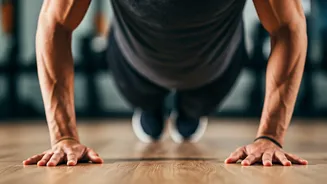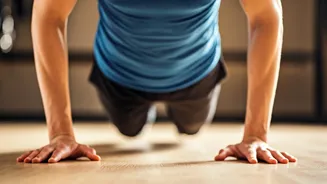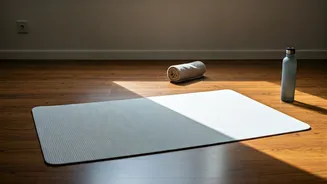Master the Form
Achieving the full benefits of a wall sit hinges on correct form, which is crucial for safety and effectiveness. Begin by standing with your back flat
against a wall, feet shoulder-width apart, and about a foot away from the wall. Slowly slide your back down the wall as if you're about to sit in an invisible chair. Bend your knees, aiming for a 90-degree angle at the knees. Ensure your thighs are parallel to the floor; your knees shouldn't extend past your toes. Keep your back pressed firmly against the wall, preventing any arching in your lower back. Maintain a neutral spine and engage your core to support your posture. Place your arms at your sides, or cross them at your chest. Hold the position for as long as possible while maintaining good form, which is vital to engage the correct muscles and prevent potential injuries. Remember to breathe steadily throughout the exercise, avoiding breath-holding, as this can elevate blood pressure and compromise your balance. This exercise effectively targets the quadriceps, hamstrings, and glutes, fostering strength and endurance.
Routine Integration
To effectively incorporate wall sits into your existing fitness regimen, consider your goals and schedule. Wall sits can act as a standalone workout for beginners or a supplemental exercise for more advanced athletes. For those new to wall sits, start with short durations like 15-20 seconds and progressively increase the hold time. If you are integrating wall sits into a broader workout, add them after exercises like squats or lunges. This helps to further fatigue your leg muscles and improve overall muscle endurance. Perform wall sits 2-3 times per week, with rest days in between to allow muscle recovery. You could also include wall sits in circuits. For example, include wall sits along with other exercises such as push-ups or planks. This will make your workout more dynamic and time-efficient. During your workout, focus on maintaining the correct form, as mentioned earlier. Try to maintain the right angle at the knees and the back against the wall. Consistency is essential for noticeable results, so try to make wall sits a regular part of your routine. This will help you to build leg strength and improve your overall fitness.
Progressive Challenges
For beginners, the progression of wall sits should be gradual to prevent injury and promote consistent improvement. Begin by holding the wall sit position for 15-20 seconds, focusing on form. Take a short break, then repeat 2-3 times. As your strength improves, increase the hold time by 5-10 seconds per set. A week or two later, try adding a third set. Once you can comfortably hold the wall sit for a minute, you can increase the challenge by trying variations. Once you're able to hold the basic wall sit for extended periods, experiment with more difficult variations. Try adding weights, like holding a dumbbell or a weight plate on your lap. This will increase the resistance and enhance muscle development. Alternatively, experiment with single-leg wall sits. Start with a shorter duration as this variation puts more strain on your muscles. The key to sustained progress is to constantly challenge yourself, listen to your body, and adjust the progression as needed. The ultimate goal is not just a longer hold time but better endurance and control over your body during the exercise.










